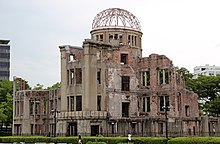Peace Memorial in Hiroshima
| Peace Memorial in Hiroshima | |
|---|---|
|
UNESCO world heritage |
|
|
|
|
| National territory: |
|
| Type: | Culture |
| Criteria : | (vi) |
| Surface: | 0.4 ha |
| Buffer zone: | 43 hectares |
| Reference No .: | 775 |
| UNESCO region : | Asia and Pacific |
| History of enrollment | |
| Enrollment: | 1996 (session 20) |
The peace memorial in Hiroshima ( Japanese 広 島 平和 記念 碑 , Hiroshima heiwa kinenhi ), also atomic bomb dome ( 原 爆 ド ー ム gembaku dōmu , English Atomic Bomb Dome , often incorrectly reproduced with an atomic bomb dome ) is a memorial for the first use of an atomic bomb . It is located in Hiroshima Peace Park .
history
The building was built according to a design by the Czech architect Jan Letzel and completed in April 1915 as the “Hiroshima Prefecture Product Exhibition Hall ” ( 広 島 県 物産 陳列館 , Hiroshima-ken Bussan Chinretsukan ). In 1921 it became the "Exhibition Center for Merchandise of the Hiroshima Prefecture" ( 広 島 県 立 商品 陳列 所 , Hiroshima-kenritsu Shōhin Chinretsusho ) and in 1933 in the “Hall for the Promotion of Industry in the Hiroshima Prefecture” ( 広 島 県 産業 奨 励 館 , Hiroshima- kenritsu Shōhin Chinretsusho ) ) renamed. The building was destroyed on August 6, 1945 at 8:16 am local time by the American atomic bomb " Little Boy " dropped by the US bomber Enola Gay and burned down completely. Everyone working in it at that point perished.
Despite the short distance of 140 meters from ground zero (Ground Zero) remained many building structures get u. a. the characteristic supporting structure of the domed roof, from which the monument owes its current name. The remains have been preserved in their former state since they were dropped.
In December 1996, UNESCO declared it a World Heritage Site on the grounds that it was “not just a powerful symbol of the most destructive force humanity has ever created; it also expresses the hope for world peace and the ultimate elimination of all nuclear weapons ”. The People's Republic of China expressed reservations that revisionists' recognition could be exploited, and the US rejected this recognition out of "lack of historical perspective."
See also
literature
- Natascha Albus and others: The UNESCO World Heritage - Monuments of humanity - Wonders of nature. Kunth, Munich 2015, ISBN 978-395504-207-3 , p. 461.
- Isa Ducke, Natascha Thoma, Manuela Hunfeld: Japan. 13th edition. Baedeker, Ostfildern 2016, ISBN 978-3-8297-1395-5 , p. 289.
Web links
- The Atomic Bomb Dome . In: Hiroshima Official Website
- Peace Memorial in Hiroshima . In: Hiroshima-Navi.or.jp
- Peace Memorial in Hiroshima on Google Arts & Culture
- Jan Knüsel: From the house to the memorial . In: Asienspiegel.ch, April 5, 2015
- Hiroshima Peace Memorial (Genbaku Dome) on the website of the World Heritage Center of UNESCO (English)
- Hiroshima Peace Memorial (Genbaku Dome) on the UNESCO YouTube channel, March 21, 2012 (video, 2:48 min., English)
Individual evidence
- ↑ Hiroshima Peace Memorial (Genbaku Dome). In: Website of the UNESCO World Heritage Center. Retrieved September 9, 2017 .
- ^ Annex V: Statements by China and the United States of America during the Inscription of the Hiroshima Peace Memorial (Genbaku Dome). In: UNESCO.org. Retrieved December 2, 2011 .
Coordinates: 34 ° 23 ′ 44.5 ″ N , 132 ° 27 ′ 12.2 ″ E



